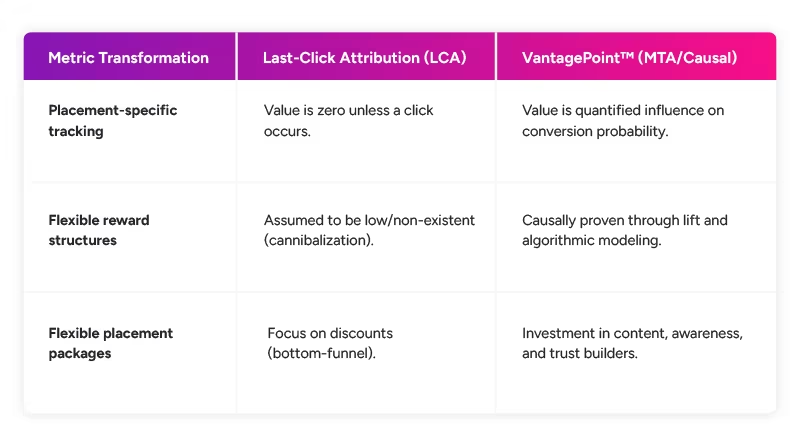A Non-Click Attribution Imperative
The pervasive myth that affiliate marketing is non-incremental—a channel that merely captures sales already driven by other marketing efforts—stems almost entirely from the industry’s reliance on the outdated last-click attribution (LCA) model. This model systematically undervalues the crucial, top, and mid-funnel influence of content-rich affiliates, reducing their role to a final transaction capture and obscuring their genuine contribution to the customer journey.
A sophisticated solution like VantagePoint™ is not just an optional upgrade; it is an “essential survival strategy” for debunking this myth by fundamentally re-architecting how affiliate value is measured.
The Flaw of Last-Click Attribution
The current operating model for many brands incorrectly views content affiliates, influencers, and niche publishers as little more than a necessary cost of conversion, purely because the tracking link is often not the last touchpoint before a sale. A customer may read a detailed product review (affiliate content), search for the brand name directly, and then convert. LCA credits the branded search, rendering the affiliate’s complex, demand-generating work as non-incremental.
This flawed accounting leads to:
- Misallocated Budgets: Underinvestment in high-value, top-of-funnel content partners.
- Suboptimal Strategy: A focus on incentivizing bottom-funnel voucher and loyalty sites, which are often truly non-incremental, while stifling genuine customer acquisition.
- Stagnant Growth: Failure to leverage affiliates as a true channel for new customer and brand awareness creation.
VantagePoint’s Role in Value Re-Alignment
VantagePoint’s value lies in its ability to move beyond click-based mechanics to offer a holistic, multi-touch attribution (MTA) framework, specifically designed to capture the non-click influence of affiliate content.
1. Content Visibility and Cross-Channel Mapping
The core capability is mapping the customer journey before the transaction. VantagePoint™ integrates with first-party data (CRM, site analytics) to correlate exposure to specific affiliate content with subsequent on-site behavior, even in the absence of a direct click.
The Solution in Action:
- Impression and View-Through Tracking: The system registers when a customer is exposed to specific affiliate-generated content (e.g., a review, an embedded video, a social post) that may not include a trackable link, but which precedes a non-affiliate-attributed site visit.
- Content-to-Conversion Pathing: VantagePoint™ analyzes the content topics, keywords, and specific affiliate partners that appeared in a customer’s journey, linking them to final conversion points across other channels (e.g., Direct, Paid Search, Email). This proves the content’s influence in driving demand, not just capturing existing intent.
2. Proving Incrementality via Causal Modeling
True incrementality is defined as the lift in sales that would not have occurred without the specific marketing intervention. VantagePoint™ moves beyond correlational data (which MTA provides) toward causal analysis through advanced modeling and testing.
The Value Proposition:
- Algorithmic Attribution: Utilizing machine learning, the system can assign fractional credit to all touchpoints—including affiliate content exposure—based on their statistical probability of influencing the conversion. This gives content affiliates their rightful weight in the customer journey.
- Lift Testing Integration: For sophisticated clients, VantagePoint™ should enable Incrementality Testing (e.g., Geo-Split or Holdout Testing) at the partner level. By isolating the effect of a specific affiliate on a statistically matched control group, the system can definitively quantify the net new revenue generated by that partner’s content, entirely bypassing the last-click debate. This shifts the conversation from “Were they the last click?” to “How much revenue would we have lost without them?”
Strategic Implications and Recommendations
VantagePoint’s robust, content-aware attribution system transforms the affiliate channel from a transactional cost-center into a strategic driver of demand and customer acquisition.

Recommendation: Reconsider Budget Allocation Across Paid Channels
The most critical strategic output from the VantagePoint™ data is the ability to re-evaluate the true Return on Ad Spend (ROAS) for other paid media.
- Identify Over-Credited Channels: VantagePoint™ will likely reveal that channels like Branded Paid Search and some forms of Retargeting Display are often over-credited by LCA, as they are simply the final click for a customer who was already convinced by earlier affiliate content exposure. Their true incremental ROAS is lower than reported.
- Quantify “Halo Effect” with the HaloIndex™ (Affiliate-Driven Savings): The data will quantify the value of affiliate content in reducing the Cost Per Acquisition (CPA) for other channels. For example, a customer influenced by a content affiliate’s review is more likely to convert upon seeing a branded search ad, effectively making the search ad cheaper to convert.
- Execute a Data-Driven Budget Shift:
- Action: Reallocate a portion of the budget from channels identified as having a low incremental ROAS (e.g., Branded Search) to the high-influence, top-of-funnel content affiliate partners.
- Goal: This strategic shift compensates content affiliates fairly for their demand-generation work, incentivizes the creation of more high-quality content, and ensures capital is invested where it drives the greatest net new business growth.
By leveraging VantagePoint™, the modern enterprise gains the data necessary to not only validate the affiliate channel but to execute a profit-maximizing budget reallocation that aligns spend with true incremental value across the entire marketing mix.
Click here to request your demo today!